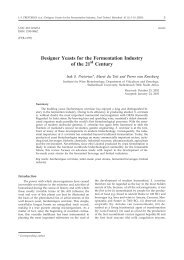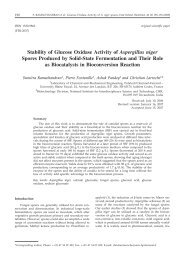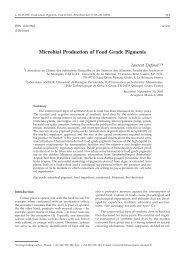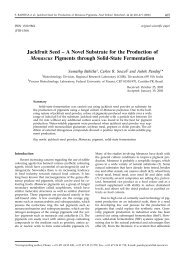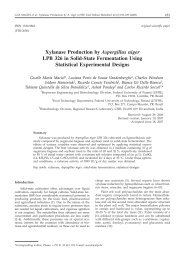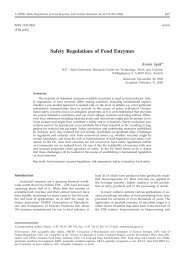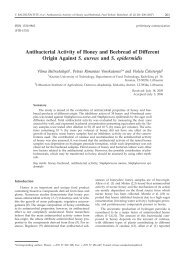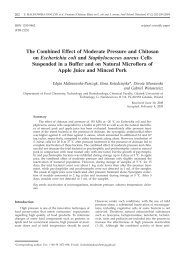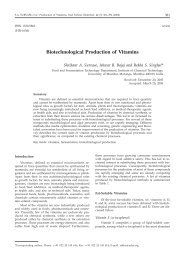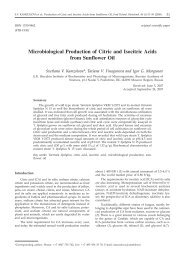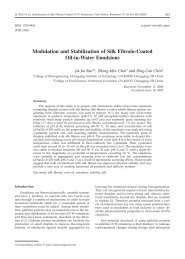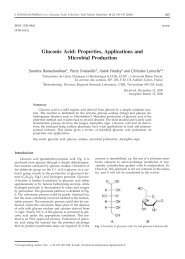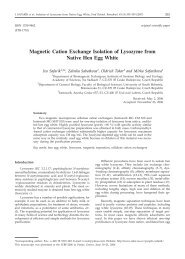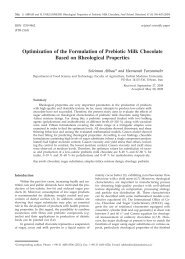Evaluation of Culture Conditions for Tannase Production by ...
Evaluation of Culture Conditions for Tannase Production by ...
Evaluation of Culture Conditions for Tannase Production by ...
You also want an ePaper? Increase the reach of your titles
YUMPU automatically turns print PDFs into web optimized ePapers that Google loves.
M. CRUZ-HERNÁNDEZ et al.: <strong>Tannase</strong> <strong>Production</strong> <strong>by</strong> A. niger GH1, Food Technol. Biotechnol. 44 (4) 541–544 (2006)<br />
ISSN 1330-9862 scientific note<br />
(FTB-1488)<br />
Introduction<br />
<strong>Evaluation</strong> <strong>of</strong> <strong>Culture</strong> <strong>Conditions</strong> <strong>for</strong> <strong>Tannase</strong> <strong>Production</strong><br />
<strong>by</strong> Aspergillus niger GH1<br />
Mario Cruz-Hernández 1 , Christopher Augur 2 , Raúl Rodríguez 1 ,<br />
Juan Carlos Contreras-Esquivel 1 and Cristóbal Noé Aguilar 1 *<br />
1 Food Research Department, Universidad Autónoma de Coahuila, Unidad Saltillo, Blvd. Venustiano<br />
Carranza PO BOX 252, ZIP 25 000, Coahuila, México<br />
2 Institut de Recherche pour le Développement, Laboratoire de Microbiologie, Université de Provence,<br />
ESIL, Case 925, Avenue de Luminy, 132888, Marseille, Cedex 9, France<br />
Received: March 10, 2005<br />
Accepted: April 28, 2005<br />
Summary<br />
Extra- and intracellular tannase production <strong>by</strong> Aspergillus niger GH1 has been evaluated<br />
using submerged (SmF) and solid-state fermentation (SSF) at different temperatures<br />
(30, 40 and 50 °C). Effects <strong>of</strong> initial substrate (tannic acid) concentration, incubation time<br />
and temperature on tannase production in SSF have been studied. A. niger GH1 produced<br />
the highest tannase level (2291 U/L) in SSF at 30 °C during the first 20 h <strong>of</strong> culture at tannic<br />
acid concentration <strong>of</strong> 50 g/L, and under these conditions enzyme production was entirely<br />
extracellular. The decline in tannase activity after 20 h <strong>of</strong> incubation was associated<br />
with a concomitant increase in protease activity.<br />
Key words: tannase, culture conditions, solid-state fermentation, Aspergillus niger<br />
<strong>Tannase</strong> or tannin acyl hydrolase (E.C. 3.1.1.20) catalyzes<br />
the hydrolysis <strong>of</strong> the ester bonds present in the hydrolysable<br />
tannins and gallic acid esters. At industrial<br />
level, it is produced <strong>by</strong> microbial means using SmF,<br />
where the activity is expressed mainly in intracellular<br />
<strong>for</strong>m, implying additional costs in its production (1).<br />
However, the commercial <strong>for</strong>ms are partly pure and have<br />
low tannase activity. At the moment, the main commercial<br />
applications <strong>of</strong> tannase are in the preparation <strong>of</strong> instant<br />
tea and manufacture <strong>of</strong> acorn liquor. <strong>Tannase</strong> is<br />
also used in the production <strong>of</strong> gallic acid (2–5), which is<br />
an important intermediary compound in the synthesis<br />
<strong>of</strong> antibacterial drugs (6). Gallic acid is a substrate <strong>for</strong><br />
the chemical or enzymatic synthesis <strong>of</strong> propyl gallate, a<br />
potent antioxidant used in the food industry (5). Besides,<br />
tannase is used as clarifying agent in some wines,<br />
fruit juices and c<strong>of</strong>fee-flavoured drinks (7–9).<br />
*Corresponding author; E-mail: cag13761@mail.uadec.mx<br />
541<br />
Recently, some studies have reported various advantages<br />
<strong>of</strong> tannase produced <strong>by</strong> SSF in comparison with that<br />
produced <strong>by</strong> SmF (7–17). Among these advantages are its<br />
high production level (up to 5.5 times more than in SmF),<br />
the extracellular nature <strong>of</strong> the enzyme and its stability in<br />
a wide range <strong>of</strong> pH and temperature (1,8,12). However,<br />
there are few microorganisms with the ability to produce<br />
tannase at high tannin concentration in spite <strong>of</strong> the fact<br />
that this compound shows antimicrobial activity.<br />
New tannin-degrading fungal strains have been isolated<br />
from semiarid regions <strong>of</strong> North Mexico (18), which<br />
have been biochemically and physiologically characterized<br />
(19,20). The strain <strong>of</strong> Aspergillus niger GH1 was isolated<br />
from the leaves <strong>of</strong> »gobernadora« (Larrea tridentate<br />
Cov.), a native plant <strong>of</strong> the Mexican semiarid region. It<br />
is the best tannin-degrading strain and is part <strong>of</strong> the<br />
fungal collection Food Research Department UAdeC.<br />
The present study was carried out to evaluate the effect
542<br />
<strong>of</strong> several culture conditions on fungal tannase production<br />
<strong>by</strong> A. niger GH1.<br />
Materials and Methods<br />
M. CRUZ-HERNÁNDEZ et al.: <strong>Tannase</strong> <strong>Production</strong> <strong>by</strong> A. niger GH1, Food Technol. Biotechnol. 44 (4) 541–544 (2006)<br />
Microorganism and inoculum<br />
Spores <strong>of</strong> A. niger GH1 were inoculated on potato<br />
dextrose agar using 250-mL Erlenmeyer flasks and incubated<br />
at 30 °C <strong>for</strong> 5 days. After this, spores were harvested<br />
with Tween 80 (volume ratio <strong>of</strong> 0.01 %) and these<br />
were then counted on a Neubauer chamber.<br />
<strong>Culture</strong> conditions<br />
Two culture systems – submerged fermentation (SmF)<br />
and solid-state fermentation (SSF) were used to produce<br />
tannase enzyme. Composition <strong>of</strong> culture medium was (in<br />
g/L): KH2PO4 2.19, (NH4) 2SO4 4.38, MgSO4·7H2O 0.44,<br />
CaCl2·7H2O 0.044, MnCl2·6H2O 0.009, NaMoO4·2H2O 0.004, FeSO4·7H2O 0.06 and tannic acid 12.5.<br />
SmF conditions included agitation at 250 rpm, temperature<br />
30 °C, initial pH= 5.5 and varying incubation<br />
time. Inoculum level was 107 spores per mL <strong>of</strong> culture<br />
medium. The solid support used in SSF was pulverized<br />
low density (20 g/L) polyurethane foam (PUF) purchased<br />
from Expomex, México, D.F. SSF was carried out<br />
at 70 % humidity. The growth kinetics <strong>of</strong> the fungal culture<br />
in SmF and SSF were periodically monitored. Crude<br />
enzymatic extracts from SmF were obtained <strong>by</strong> filtering,<br />
while the extracts from SSF were obtained <strong>by</strong> compression<br />
<strong>of</strong> the fermented material. In SmF, intracellular<br />
tannase extracts were obtained from mycelial cells retained<br />
on filter paper <strong>by</strong> washing with physiological solution,<br />
freezing with liquid nitrogen and milling in a mortar,<br />
while in SSF the fermented material (cells and PUF)<br />
was similarly treated; in both cases the macerate was recovered<br />
with buffer solution (acetate 100 mM, pH=5.5).<br />
All experiments were conducted in triplicate.<br />
<strong>Tannase</strong> assay<br />
The tannase activity was evaluated <strong>by</strong> the spectrophotometric<br />
method reported <strong>by</strong> Sharma et al. (21), using<br />
methyl gallate prepared in 0.05 M citrate buffer (pH=5)<br />
as substrate, citrate buffer 0.05 M (pH=5) as control and<br />
the crude enzymatic extract. For the colour reaction the<br />
methanolic rhodanine (0.67 % <strong>by</strong> mass per volume) and<br />
potassium hydroxide (0.5 M) were used. This reaction<br />
was monitored <strong>by</strong> measuring absorbance at 520 nm. One<br />
unit <strong>of</strong> tannase was defined as the amount <strong>of</strong> enzyme<br />
able to release one µmol <strong>of</strong> gallic acid <strong>for</strong>med per min<br />
under assay conditions (temperature and time).<br />
Protease activity assay<br />
Protease activity was assayed <strong>by</strong> the method <strong>of</strong> Dosoretz<br />
et al. (22). Substrate solution was prepared with 5<br />
mg <strong>of</strong> azocasein dissolved in 1 mL <strong>of</strong> citrate buffer (50<br />
mM, pH=5). To this solution, 0.05 mL <strong>of</strong> the crude enzymatic<br />
extract were added and the mixture was incubated<br />
<strong>for</strong> 1 h at 30 °C. Then 0.15 mL <strong>of</strong> trichloroacetic acid<br />
(5 %, volume ratio) were added and the mixture centrifuged<br />
at 12 000 rpm <strong>for</strong> 2 min. The obtained supernatant<br />
was spectrophotometrically evaluated at 520 nm.<br />
One unit <strong>of</strong> protease activity was defined as the amount<br />
<strong>of</strong> enzyme necessary to release 1 mol <strong>of</strong> chromophoric<br />
group <strong>of</strong> the substrate, which produced a change <strong>of</strong> absorbance<br />
<strong>of</strong> 0.001 under assay conditions.<br />
Substrate degradation<br />
Substrate uptake was determined <strong>by</strong> the spectrophotometric<br />
method reported <strong>by</strong> Dubois et al. (23) and<br />
modified <strong>by</strong> Aguilar et al. (24), using tannic acid as standard.<br />
Protein content<br />
For protein content estimation <strong>of</strong> the crude enzymatic<br />
extract, the microassay <strong>of</strong> Brad<strong>for</strong>d (Bio-Rad ® Protein<br />
Assay, No. 500.0002) was used. Samples were measured<br />
at 595 nm.<br />
Statistical analysis<br />
All results were analyzed using the general lineal<br />
procedure and comparison <strong>of</strong> means <strong>by</strong> Tukey’s test (p=<br />
0.05). A statistical computer program developed <strong>by</strong> the<br />
Universidad Autónoma de Nuevo León was employed.<br />
Results and Discussion<br />
Results obtained from this comparative study <strong>of</strong><br />
tannase production using SmF and SSF systems are reported<br />
in Table 1. The strain <strong>of</strong> A. niger GH1 had a higher<br />
tannase activity on SSF (more than four times) as<br />
compared to SmF, and this observation is similar to the<br />
results previously reported (1,7–17). It is important to<br />
note that <strong>for</strong> tannase production, the used model (substrate-support)<br />
resulted in enhanced enzyme induction.<br />
This result also indicates that A. niger GH1 strain can be<br />
adapted <strong>for</strong> SSF system and utilizes the nutrients in a<br />
better <strong>for</strong>m than when it is grown in other culture systems,<br />
like SmF.<br />
Table 1. Comparative tannase production <strong>by</strong> Aspergillus niger GH1<br />
using submerged and solid-state fermentation (at 30 °C <strong>for</strong> 30 h)<br />
<strong>Culture</strong><br />
system<br />
Extracellular<br />
tannase<br />
activity/(U/L)<br />
Intracellular<br />
tannase<br />
activity/(U/L)<br />
Total<br />
tannase/(U/L)<br />
SmF 537 n.d. 537<br />
SSF 2291 n.d. 2291<br />
n.d. Enzyme activity was not detected under culture conditions<br />
after 30 h<br />
After the selection <strong>of</strong> the culture system, the effect<br />
<strong>of</strong> initial level <strong>of</strong> substrate-inducer on tannase production<br />
was evaluated. Fig. 1 shows the tannase activity<br />
produced under these conditions. It was observed that<br />
<strong>by</strong> increasing the substrate concentration from 12.5 to 50<br />
g/L, the tannase activity increased (Fig. 1a). At 20 h <strong>of</strong><br />
incubation, when an initial concentration <strong>of</strong> 100 g/L was<br />
used, no tannase activity could be detected as the fungal<br />
growth was in a prolonged lag phase. Fig. 1b shows that<br />
<strong>by</strong> using an initial tannic acid concentration <strong>of</strong> 50 g/L,<br />
the specific activity was higher than with other levels <strong>of</strong><br />
the tested substrate.
M. CRUZ-HERNÁNDEZ et al.: <strong>Tannase</strong> <strong>Production</strong> <strong>by</strong> A. niger GH1, Food Technol. Biotechnol. 44 (4) 541–544 (2006)<br />
<strong>Tannase</strong> activity/(U/L)<br />
2500<br />
2000<br />
1500<br />
1000<br />
<strong>Tannase</strong> activity/(U/mg)<br />
500<br />
0<br />
9<br />
8<br />
7<br />
6<br />
5<br />
4<br />
3<br />
2<br />
1<br />
0<br />
20 h 40 h<br />
12.5 25 50 100<br />
20 h 40 h<br />
g /(g/L)<br />
12.5 25 50 100<br />
g /(g/L)<br />
Fig. 1. Effect <strong>of</strong> initial substrate-inducer concentration on tannase<br />
activity (a) and specific activity (b) in SSF <strong>of</strong> A. niger GH1 at<br />
30 °C<br />
These results demonstrated the capacity <strong>of</strong> the fungus<br />
to grow on high concentrations <strong>of</strong> a compound characterized<br />
<strong>by</strong> its antimicrobial activity. Only Aspergillus<br />
species are able to tolerate tannic acid in concentrations<br />
higher than 20 g/L. Aguilar et al. (24) reported the effect<br />
<strong>of</strong> the concentrations <strong>of</strong> tannic acid on tannase production<br />
<strong>by</strong> A. niger Aa-20.<br />
Fig. 2 shows the substrate concentration during the<br />
kinetics <strong>of</strong> tannase production using 50 g/L <strong>of</strong> tannic<br />
acid. It is easy to determine the fermentation time, due<br />
to a high concentration <strong>of</strong> substrate consumed <strong>by</strong> the<br />
strain in the first few hours <strong>of</strong> growth.<br />
The tannase activity, which was initially detected at<br />
18 h <strong>of</strong> culture, reached a peak at 24 h. <strong>Tannase</strong> production<br />
decreased and protease activity increased at 30 h<br />
(Fig. 3a). The effect <strong>of</strong> protease on tannase activity observed<br />
in the present study confirms the observations<br />
reported <strong>by</strong> Aguilar et al. (15) that protease influences<br />
the production <strong>of</strong> tannase and causes a decrease in its<br />
activity. These results also indicate the need <strong>for</strong> further<br />
purification <strong>of</strong> the enzyme.<br />
The incubation time required <strong>for</strong> the production <strong>of</strong><br />
the tannase enzyme <strong>by</strong> A. niger GH1 in SSF was lower<br />
than the culture time <strong>of</strong> 120 h reported <strong>by</strong> Sharma et al.<br />
(21), using a strain <strong>of</strong> A. niger van Tieghem.<br />
The above results have significant implications <strong>for</strong><br />
tannase production because the strain A. niger GH1 has<br />
the capacity to degrade tannic acid rapidly and at high<br />
concentrations. Other authors have reported tannase production<br />
in media with glucose and tannic acid and fermentation<br />
time <strong>of</strong> 100 h (25–27). Most <strong>of</strong> the published<br />
a<br />
b<br />
g(tannic acid)/(g/L)<br />
16<br />
14<br />
12<br />
10<br />
8<br />
6<br />
4<br />
2<br />
0<br />
0 8 16 24<br />
t/h<br />
32 40 48<br />
543<br />
Fig. 2. Substrate utilization during the course <strong>of</strong> tannase production<br />
<strong>by</strong> A. niger GH1 at 30 °C in SSF with 12.5 g/L <strong>of</strong> tannic<br />
acid<br />
<strong>Tannase</strong> activity/(U/L)<br />
Protease activity/(U/ L·min)<br />
1200<br />
1000<br />
800<br />
600<br />
400<br />
200<br />
0<br />
0 6 12 18 24 30 36 42<br />
t/h<br />
10<br />
9<br />
8<br />
7<br />
6<br />
5<br />
4<br />
3<br />
2<br />
1<br />
0<br />
0 6 12 18 24 30 36 42<br />
Fig 3. <strong>Tannase</strong> (a) and protease (b) activities produced <strong>by</strong> A. niger<br />
GH1 strain at 30 °C in SSF with tannic acid concentration <strong>of</strong><br />
50 g/L<br />
t/h<br />
a<br />
b
544<br />
work on tannase purification reports the use <strong>of</strong> mycelial<br />
mass to obtain the protein due to its intracellular nature<br />
(25,28,29). The other advantage in the use <strong>of</strong> this strain<br />
is the <strong>for</strong>m <strong>of</strong> expression <strong>of</strong> the enzyme, because in SSF<br />
it is wholly extracellular. These conditions represent a<br />
system <strong>for</strong> an easy recovery <strong>of</strong> enzyme protein using<br />
fewer steps with high yield.<br />
Conclusions<br />
The culture conditions <strong>for</strong> the production <strong>of</strong> tannase<br />
enzyme from A. niger GH1 strain were evaluated and<br />
standardized. These conditions were: solid-state fermentation<br />
with polyurethane as support, incubation temperature<br />
<strong>of</strong> 30 °C, fermentation time <strong>of</strong> 24 h, substrate concentration<br />
<strong>of</strong> 50 g/L <strong>of</strong> tannic acid. These culture conditions<br />
can be used <strong>for</strong> further studies on the purification,<br />
immobilization and applications <strong>of</strong> tannase from A. niger<br />
GH1.<br />
Acknowledgements<br />
Authors want to thank the financial support »Fondo<br />
sectorial SEP-CONACYT«, project 42244, »Fondo mixto<br />
COAHUILA-CONACYT«. This report is part <strong>of</strong> the project<br />
M02-A02 conducted within the framework <strong>of</strong> the<br />
ECOS-Nord-CONAYT-ANUIES program between Mexico<br />
and France.<br />
References<br />
M. CRUZ-HERNÁNDEZ et al.: <strong>Tannase</strong> <strong>Production</strong> <strong>by</strong> A. niger GH1, Food Technol. Biotechnol. 44 (4) 541–544 (2006)<br />
1. P.K. Lekha, B.K. Lonsane, Comparative titres, location and<br />
properties <strong>of</strong> tannin acyl hydrolase produced <strong>by</strong> Aspergillus<br />
niger PKL 104 in solid-state, liquid surface and submerged<br />
fermentations, Process Biochem. 29 (1994) 497–503.<br />
2. P. Coggon, N.H. Graham, G.W. Sanderson, Cold water soluble<br />
tea. UK Patent 2,610,533 (1975).<br />
3. S. Chae, T. Yu, Experimental manufacture <strong>of</strong> acorn wine<br />
<strong>by</strong> fungal tannase, Hanguk Sipkum Kwahakoechi, 15 (1983)<br />
326–332.<br />
4. H. Pourrat, F. Regerat, A. Pourrat, D. Jean, <strong>Production</strong> <strong>of</strong><br />
gallic acid from tara tannin <strong>by</strong> a strain <strong>of</strong> A. niger, J. Ferment.<br />
Technol. 63 (1985) 401–403.<br />
5. J.A. García-Nájera, A. Medina, Y. Castro, M.L. Reyes-Vega,<br />
A. Prado-Barragán, C.N. Aguilar, Accumulation and recovery<br />
<strong>of</strong> gallic acid in submerged culture <strong>of</strong> Aspergillus niger<br />
Aa-20, 2002 Annual Meeting, Institute <strong>of</strong> Food Technologists,<br />
IFT, Anaheim, CA, USA (2002).<br />
6. M. Sittig: Trimethoprim. In: Pharmaceutical Manufacturing<br />
Encylopedia, Noyes Publication, New Jersey, USA (1988)<br />
pp. 282–284.<br />
7. P.K. Lekha, B.K. Lonsane, <strong>Production</strong> and application <strong>of</strong><br />
tannin acyl hydrolase: State <strong>of</strong> the art, Adv. Appl. Microbiol.<br />
44 (1997) 215–260.<br />
8. C.N. Aguilar, G. Gutiérrez-Sánchez, Review: Sources, properties,<br />
applications and potential uses <strong>of</strong> tannin acyl hydrolase,<br />
Food Sci. Technol. Int. 7 (2001) 373–382.<br />
9. R. Belmares-Cerda, J.C. Contreras-Esquivel, R. Rodríguez,<br />
A. Ramírez-Coronel, C.N. Aguilar, Microbial production <strong>of</strong><br />
tannase: An enzyme with potential use in food industry,<br />
Lebensm. Wiss. Technol. 37 (2004) 857–864.<br />
10. R. Chatterjee, A. Dutta, R. Banerjee, B.C. Bhattacharyya,<br />
<strong>Production</strong> <strong>of</strong> tannase <strong>by</strong> solid state fermentation, Bioprocess<br />
Eng. 14 (1994) 159–192.<br />
11. I. García-Peña, <strong>Production</strong>, purification and characterization<br />
<strong>of</strong> tannase produced <strong>by</strong> A. niger in solid-state fermen-<br />
tation, MSc Thesis, Universidad Autónoma Metropolitana,<br />
Iztapalapa, México (1996).<br />
12. A. Ramirez-Coronel, Purification and characterization <strong>of</strong> a<br />
tannase from Aspergillus niger Aa-20 produced <strong>by</strong> solid<br />
state fermentation, MSc Thesis, Universidad Autónoma<br />
Metropolitana, Iztapalapa, México (2000).<br />
13. C.N. Aguilar, C. Augur, E. Favela-Torres, G. Viniegra-González,<br />
Induction and repression patterns <strong>of</strong> fungal tannase<br />
in solid state and submerged cultures, Process Biochem. 36<br />
(2001) 571–578.<br />
14. C.N. Aguilar, C. Augur, E. Favela-Torres, G. Viniegra-González,<br />
<strong>Production</strong> <strong>of</strong> tannase <strong>by</strong> Aspergillus niger Aa-20 in<br />
submerged and solid state fermentations: Influence <strong>of</strong> glucose<br />
and tannic acid, J. Ind. Microbiol. Biotechnol. 26 (2001)<br />
296–302.<br />
15. C.N. Aguilar, E. Favela-Torres, G. Viniegra-González, C. Augur,<br />
<strong>Culture</strong> conditions dictate protease and tannase production<br />
in submerged and solid state cultures <strong>of</strong> Aspergillus<br />
niger Aa-20, Appl. Biochem. Biotechnol. 102 (2002) 407–413.<br />
16. G. Viniegra-González, E. Favela-Torres, C.N. Aguilar, S.J.<br />
Romero-Gómez, G. Díaz-Godínez, C. Augur, Advantages<br />
<strong>of</strong> fungal enzyme production in solid state over liquid fermentation<br />
systems, Biochem. Eng. J. 13 (2003) 157–167.<br />
17. J. Van de Lagenmaat, D.L Pyle, Solid-state fermentation and<br />
bioremediation: Development <strong>of</strong> a continuous process <strong>for</strong><br />
the production <strong>of</strong> fungal tannase, Chem. Eng. J. 84 (2001)<br />
115–123.<br />
18. M.A. Cruz-Hernandez, Isolation and morphological characterization<br />
<strong>of</strong> tannin-degrading fungal strains, MSc Thesis,<br />
Universidad Autónoma de Coahuila, México (2002).<br />
19. C.N. Aguilar, M. Cruz, R. Rodríguez, G. Gutierrez-Sanchez,<br />
A. Ramírez-Coronel, C. Augur, Catechin degradation<br />
<strong>by</strong> several fungal strains isolated from Mexican desert, J.<br />
Microbiol. Biotechnol. 14 (2004) 426–429.<br />
20. M.A. Cruz-Hernandez, J.C. Contreras-Esquivel, F. Lara, R.<br />
Rodríguez-Herrera, C.N. Aguilar, Isolation and evaluation<br />
<strong>of</strong> tannin-degrading strains from the Mexican desert, Z.<br />
Natur<strong>for</strong>sch. C, 60 (2005) 844–848.<br />
21. S. Sharma, T.K. Bhat, R.K. Dawra, Isolation, purification<br />
and properties <strong>of</strong> tannase from Aspergillus niger van Tieghem,<br />
World J. Microbiol. Biotechnol. 15 (1999) 673–677.<br />
22. C. Dosoretz, H. Chih-Chen, H. Grethlein, Effect <strong>of</strong> environmental<br />
conditions on extracellular protease activity in<br />
lignolytic cultures <strong>of</strong> Phanerochaete chrysosporium, Appl.<br />
Environ. Microbiol. 56 (1999) 395–400.<br />
23. M. Dubois, K.A. Guiles, J.K. Hamilton, P.A. Rebers, F.<br />
Smith, Colorimetric method <strong>for</strong> determination <strong>of</strong> sugar<br />
and related substances, Anal. Chem. 25 (1956) 530.<br />
24. C.N. Aguilar, C. Augur, G. Viniegra-Gonzalez, E. Favela-<br />
-Torres, Influence <strong>of</strong> Carbon Source on <strong>Tannase</strong> <strong>Production</strong><br />
<strong>by</strong> Aspergillus niger Aa-20 in Solid State <strong>Culture</strong>. In: C<strong>of</strong>fee<br />
Biotechnology and Quality, Vol. 44 (2000) 461–470.<br />
25. C. Barthomeuf, F. Regerat, H. Pourrat, Improvement in<br />
tannase recovery using enzymatic disruption on mycelium<br />
in combination with reverse mycelar enzyme extraction,<br />
Biotechnol. Tech. 8 (1994) 137–142.<br />
26. R. Bhardwaj, T.K. Bhat, B. Singh, Purification and characterization<br />
<strong>of</strong> tannin acyl hydrolase from Aspergillus niger<br />
MTCC-2425, J. Basic Microbiol. 43 (2003) 449–461.<br />
27. M.A. Ramirez-Coronel, G. Viniegra-González, A. Darvill,<br />
C. Augur, A novel tannase from Aspergillus niger with bglucosidase<br />
activity, Microbiology, 149 (2003) 2941–2946.<br />
28. G. Rajakumar, S. Nandy, Isolation, purification and some<br />
properties <strong>of</strong> Penicillum chrysogenum tannase, Appl. Environ.<br />
Microbiol. 46 (1983) 525–527.<br />
29. K. Yamada, S. Iibuchi, Y. Minoda, Studies on tannin acyl<br />
hydrolase <strong>of</strong> microorganisms. Isolation and identification<br />
<strong>of</strong> producing molds and studies on the conditions <strong>of</strong> cultivation,<br />
Agr. Biol. Chem. 45 (1968) 233–240.
FTB 44 (4) 541-544.<br />
Sažetak<br />
Procjena uvjeta uzgoja za proizvodnju tanaze s pomoću<br />
plijesni Aspergillus niger GH1<br />
Ispitana je ekstracelularna i intracelularna proizvodnja tanaze submerznim uzgojem<br />
plijesni Aspergillus niger GH1 u tekućoj te površinskim uzgojem na čvrstoj podlozi pri<br />
različitim temperaturama (30, 40 i 50 °C). Istražen je utjecaj koncentracije početnog supstrata<br />
(taninske kiseline), vremena inkubacije i temperature na proizvodnju tanaze pri uzgoju na<br />
čvrstoj podlozi. Soj A. niger GH1 proizveo je najviše tanaze (2291 U/L) tijekom prvih 20 sati<br />
uzgoja pri koncentraciji taninske kiseline od 50 g/L. U tim uvjetima proizvodnje enzim je u<br />
potpunosti bio ekstracelularan. Opadanje aktivnosti tanaze nakon 20 sati ugoja povezano je s<br />
pratećim porastom aktivnosti proteaze.



